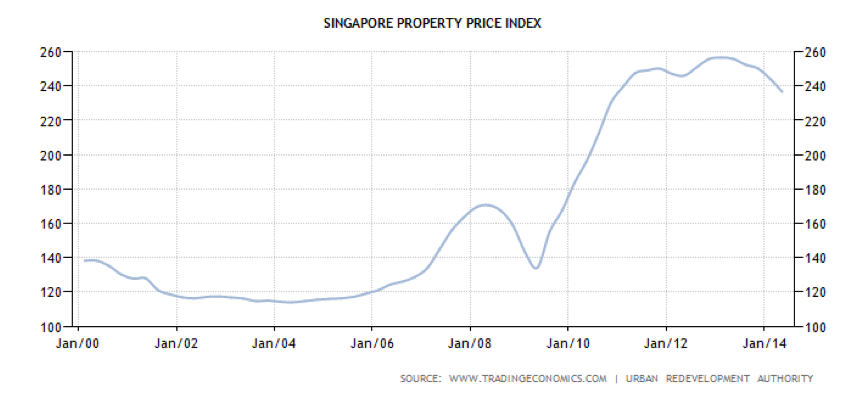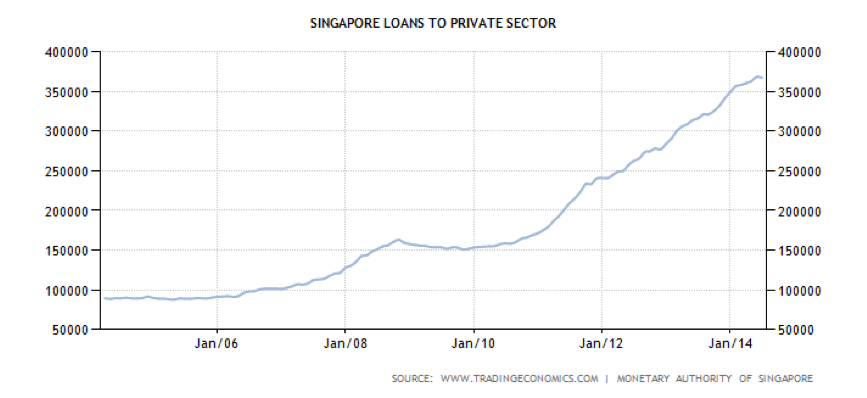Singapore is regarded as the “safe haven” or Switzerland of Asia. While on the surface Singapore is the economy to which most others can only aspire to one day become, beneath the scenes is a very fragile economy highly dependent on the cost of capital staying low or at least rising very slowly over the coming years. If rates in the US rise sooner than what everyone expects and by a greater magnitude, the Singapore economy and dollar are in big trouble!
Lets get straight to the point – Singapore has a huge problem and it relates to its property market, property prices have advanced some 50% since the start of 2006! 
High property prices in themselves aren’t a problem. The problem is essentially the way in which the property market is financed but more on that later.
What has caused this insane rise in property prices? From the chart above notice that most of the price movement occurred from 2009 – 2013. This was a period in which the US Fed engaged in what seemed an infinite “quantitative easing” program which took short-term rates down to virtually zero percent.
The Feds quantitative easing program has had far-reaching consequences for which it has openly stated that it doesn’t care (everything is ok as long as it is in the interests of the US). One way the stimulus manifests itself is as bubbles in other economies, particularly of the emerging variety, where the ultra-low rate set by the Fed has been exponentially compounding what was already a serious problem caused by China’s seemingly insatiable appetite for growth.
Singapore’s benchmark interest rate, the SIBOR, is tied to the U.S. Fed Funds Rate to minimize large swings in the exchange rate. Low interest rates are a direct cause of credit bubbles, and this is what is happening in Singapore.
Since the SIBOR is used to price the majority of loans and mortgages in Singapore, a very low SIBOR means cheap credit in Singapore. The ratio of household debt to gross domestic product now stands at around 77%, up from 55% in 2010 and 45% in 2005.
Furthermore, almost all mortgages in Singapore now have floating interest rates, meaning that once the Fed tapers, mortgage repayments will increase too, exposing unsustainable debt levels in the system. Lets take a closer look at this stupidity.
The average mortgage rate in Singapore is now approximately 1%. This is ok as long as rates don’t move. Looking at the history of the fed funds rate, which was at 5% as recently as 2007, it has trended between 3% and 6% for the last several decades. If (or should I say when) Fed rates return to their historical averages after this exceptionally long period of low rates, Singapore’s housing market will discover a double whammy of underwater homes and unaffordable interest payments.
At 2%, interest payments in Singapore will more than overwhelm the principal and double monthly payments. It isn’t hard to see how disposable income and consumer spending in Singapore is so vulnerable to rising interest rates. 
Singapore is not alone in its fragility to rising interest rates. What is happening in Singapore symptom of broader macro theme (consumers gorging themselves on cheap credit). There is a region-wide emerging markets bubble, encompassing not just Singapore, but also Malaysia, Thailand, the Philippines, Indonesia, Australia and New Zealand. Singapore just happens to be the financial hub of the region and thus benefits from the skyrocketing price indices and booming household debt, as long as it lasts.
This emerging markets bubble is likely to burst, once the Chinese bubble and thus commodity prices pop (which they now appear to be doing). Given the makeup of Singapore’s economy, mainly characterized by finance and real estate, the chain of events could unfold in a way that echoes the financial crisis in Iceland and Ireland. However, as is usual with bubbles, they tend to be flat-out denied until they burst for little or no apparent reason.
The Economist labels Singapore as the third most expensive residential property market in the world, on a price-to-rent basis, causing a 60% overvaluation relative to the long-term average. Only Canada and Hong Kong are pricier. If the property market goes, so does the banking sector, since the banks hold almost 50% of their credit portfolios in property-related loans, residential mortgages making up nearly a third. Given that the vast majority of loans have floating rates, these banks are in for a horrible wakeup call on the bad loan front as rates rise.
The evolution of Singapore’s bubble is closely tied to US monetary policy, and though the causality is far from clear, Singaporean home price indices did reflect the first decline in seven quarters in 2013 Q4 and have been declining ever since, as the Fed started and continues to “taper”. Since the process of returning to non-zero interest rates in the US is likely to be extremely slow, the bursting of Singapore’s bubble is hardly imminent. However, there is always the risk that rates in the US rise sooner than expected because, if history is anything to go by, rarely do expectations match reality.
As the Fed moves towards raising rates the risk must certainly be that rates rise sooner than expected. Why do I get the feeling that we are sitting precariously close to a repeat of the 1997 Asian Tiger crisis? If one of Singapore, Malaysia, Indonesia, the Philippines, Thailand, Hong Kong, or Australia or that matter gets into trouble then the rest go. Of course I didn’t even need to mention China!
Expressing bearish views on the Singapore dollar is a great way to position for rising rates in the US and any crisis that is likely to materialize from rising rates. The preference is to express the view via long term call options on the USD/SGD.
- English (UK)
- English (India)
- English (Canada)
- English (Australia)
- English (South Africa)
- English (Philippines)
- English (Nigeria)
- Deutsch
- Español (España)
- Español (México)
- Français
- Italiano
- Nederlands
- Português (Portugal)
- Polski
- Português (Brasil)
- Русский
- Türkçe
- العربية
- Ελληνικά
- Svenska
- Suomi
- עברית
- 日本語
- 한국어
- 简体中文
- 繁體中文
- Bahasa Indonesia
- Bahasa Melayu
- ไทย
- Tiếng Việt
- हिंदी
Why the Singapore Dollar is Starring Into the Abyss
Published 10/02/2014, 04:33 AM
Updated 07/09/2023, 06:31 AM
Why the Singapore Dollar is Starring Into the Abyss
3rd party Ad. Not an offer or recommendation by Investing.com. See disclosure here or
remove ads
.
Latest comments
Install Our App
Risk Disclosure: Trading in financial instruments and/or cryptocurrencies involves high risks including the risk of losing some, or all, of your investment amount, and may not be suitable for all investors. Prices of cryptocurrencies are extremely volatile and may be affected by external factors such as financial, regulatory or political events. Trading on margin increases the financial risks.
Before deciding to trade in financial instrument or cryptocurrencies you should be fully informed of the risks and costs associated with trading the financial markets, carefully consider your investment objectives, level of experience, and risk appetite, and seek professional advice where needed.
Fusion Media would like to remind you that the data contained in this website is not necessarily real-time nor accurate. The data and prices on the website are not necessarily provided by any market or exchange, but may be provided by market makers, and so prices may not be accurate and may differ from the actual price at any given market, meaning prices are indicative and not appropriate for trading purposes. Fusion Media and any provider of the data contained in this website will not accept liability for any loss or damage as a result of your trading, or your reliance on the information contained within this website.
It is prohibited to use, store, reproduce, display, modify, transmit or distribute the data contained in this website without the explicit prior written permission of Fusion Media and/or the data provider. All intellectual property rights are reserved by the providers and/or the exchange providing the data contained in this website.
Fusion Media may be compensated by the advertisers that appear on the website, based on your interaction with the advertisements or advertisers.
Before deciding to trade in financial instrument or cryptocurrencies you should be fully informed of the risks and costs associated with trading the financial markets, carefully consider your investment objectives, level of experience, and risk appetite, and seek professional advice where needed.
Fusion Media would like to remind you that the data contained in this website is not necessarily real-time nor accurate. The data and prices on the website are not necessarily provided by any market or exchange, but may be provided by market makers, and so prices may not be accurate and may differ from the actual price at any given market, meaning prices are indicative and not appropriate for trading purposes. Fusion Media and any provider of the data contained in this website will not accept liability for any loss or damage as a result of your trading, or your reliance on the information contained within this website.
It is prohibited to use, store, reproduce, display, modify, transmit or distribute the data contained in this website without the explicit prior written permission of Fusion Media and/or the data provider. All intellectual property rights are reserved by the providers and/or the exchange providing the data contained in this website.
Fusion Media may be compensated by the advertisers that appear on the website, based on your interaction with the advertisements or advertisers.
© 2007-2024 - Fusion Media Limited. All Rights Reserved.
